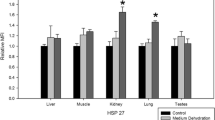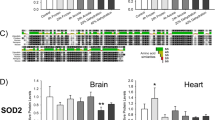Abstract
The role of two vertebrate mitogen-activated protein kinases (MAPKs) in mediating responses to in vivo anoxia or freezing exposures was examined in four organs (liver, heart, kidney and brain) of hatchling red-eared turtles, Trachemys scripta elegans, which are naturally tolerant of these stresses. The extracellular signal-regulated kinases were not stress-activated except in brain of frozen turtles. The c-Jun NH2-terminal kinases (JNKs) were transiently activated by anoxia exposure in all four organs (after 1 h in brain or 5 h in other organs) but activity was suppressed during freezing except in brain which showed a transient activation of JNK after 1 h. Changes in the concentrations of the transcription factors, c-Fos and c-Myc, were also stress- and organ-specific. The patterns of MAPK activation in a stress-tolerant animal suggest the relative importance of these kinase pathways in cellular adaptation to oxygen deprivation or freezing and identify novel natural activators of MAPKs in vivo. The specificity of the signaling pathways is also emphasized here as the general whole-body stresses, anoxia and freezing, activated individual MAPKs in a tissue-, time-, and stress-dependent manner.
Similar content being viewed by others
Author information
Authors and Affiliations
Additional information
Accepted: 30 June 1999
Rights and permissions
About this article
Cite this article
Greenway, S., Storey, K. Discordant responses of mitogen-activated protein kinases to anoxia and freezing exposures in hatchling turtles. J Comp Physiol B 169, 521–527 (1999). https://doi.org/10.1007/s003600050251
Issue Date:
DOI: https://doi.org/10.1007/s003600050251




